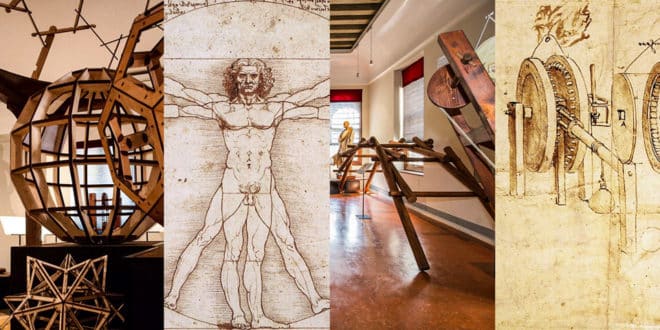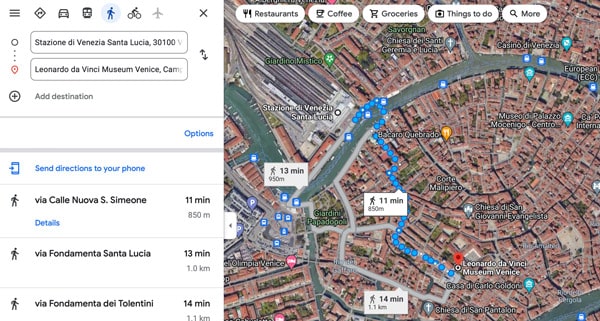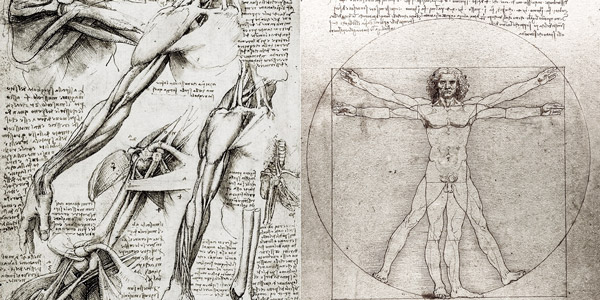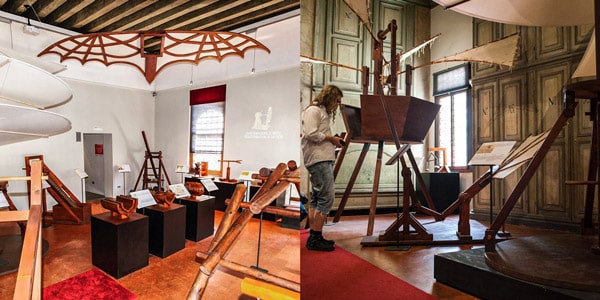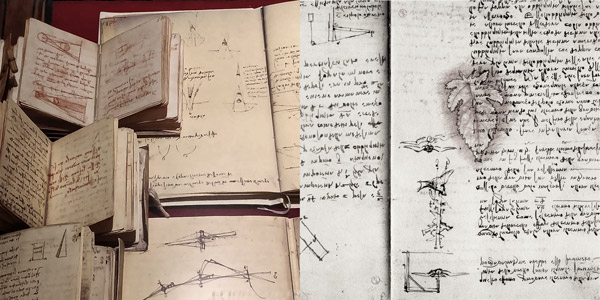The Museo Leonardo da Vinci in Venice (Venezia) is a fascinating interactive exhibition showcasing the life and masterpieces of the greatest genius in the history of mankind, Leonardo da Vinci.
The state-of-the-art museum is dedicated to the paintings, manuscripts, and inventions of the most prominent man of the Renaissance. Even in the third millennium, the world does not cease to admire the talent of the Florentine master, who was centuries ahead of his time. He created masterpieces that carry the eternal mystery of knowledge and discovery, touching almost all aspects of human life.
Page Contents
Where to go, opening times, tickets.
The Leonardo da Vinci Museum is located in the heart of Venice’s historic center, in the San Polo neighborhood of Campo San Rocco. You can reach the central station of Venezia Santa Lucia in just over 10 minutes on foot.
The exhibition space is occupied by the two-story building Scoletta, which is an integral part of the monumental San Rocco complex, created by the brotherhood of monks in the XV century.
Nearby is the Church of San Rocco, the Basilica of Santa Maria Gloriosa dei Frari, and the Scuola Grande di San Rocco.
The museum is open daily from 10:30 a.m. to 6:30 p.m. The last entrance is at 5:15 p.m. Tickets cost 8 EUR and one can buy in advance using the form below:
The ticket price includes an audio guide in English, Spanish, Italian, German, Portuguese, Russian, or French.
Organization of the exhibition space
The Leonardo da Vinci Museum is located on two floors of the old building and occupies about 500 square meters. On this small area are put digital copies of famous paintings, manuscripts, technical and anatomical drawings, and more than 60 items of perfectly functioning mechanisms made in life-size according to the sketches of the great master.
A tour of the exhibition takes about 45-60 minutes and ends with a projection with information about the life and work of Leonardo.
In the museum building, there is a store where you can buy books about the great genius. As well as reproductions of his paintings and even miniature models of the inventor: polyhedrons, an arch bridge, the flying machine, and a geodesic dome.
Paintings
On the first floor of the Leonardo da Vinci Museum are located reproductions of the most beautiful and famous works of the Italian Renaissance master: “Gioconda”, “Lady with an ermine,” “Annunciation,” “The Last Supper,” and others.
Anatomical drawings
Along with copies of paintings, the museum also features copies of Leonardo da Vinci’s anatomical drawings: skulls, proportions of the human face and body, blood vessel system, internal organs, musculature, embryonic development, and others.
The most famous drawing by Leonardo is the Vitruvian Man. It’s an illustration for a book devoted to the works of the ancient Roman architect Vitruvius. The artist showed the ratio of ideal human proportions to geometric figures, so-called ‘golden ratio’. The original of this drawing has been placed in the Venetian Academy of Fine Arts since 1818. And is exhibited on very rare occasions.
The study of the human and animal body, as well as their comparison, was a favorite subject of the artist in his scientific studies. His first drawings, based only on theoretical knowledge, differ from later depictions of the human internal structure. The practice of dissecting corpses (inadmissible at the time) helped him learn more about body anatomy and use this experience to convey authentic images in his paintings.
Mechanisms
One can find Leonardo’s inventions on the second floor. The themes of the exhibitoin include the four natural elements: “Water”, “Air,” “Earth,” and “Fire.”
The specialists made the life-size models of mechanisms with care and exactly according to the drawings of the author. The basis of ingenious inventions is the laws of physics and mechanics, which were unknown to science at the time. Such designs include the tank, machine gun, flying machine, helicopter, parachute, hydraulic devices, and throwing guns. Each machine has a description of its operating principles. And you can see them in action. They equipped the halls with multimedia displays, allowing one to imagine the movements of the mechanisms in detail.
Even though, Leonardo da Vinci hated war and called it “animal madness” (bestialissima pazzia) in his notes. At the same time, he earned fame as a gifted military engineer by designing fortification plans and killing machines. The internecine strife and the threat of French intervention in Italy prompted Leonardo to create ingenious machines. Not all of them found practical use, as they required refinement and were too unusual for combat. For example, a wooden armored vehicle in the form of a turtle (a prototype of a future tank) could only move forward, controlled inside by eight “operators”.
Wooden models of a bicycle, car and lathe look quite recognizable and are quite workable.
Manuscripts
The museum presents a digitized version of a very valuable and rare collection of Leonardo da Vinci’s manuscripts.
Much of the genius’ scientific work has not survived. That’s why all the more valuable are the extant notes and drafts accompanied by sketches and diagrams.
What is interesting is that Leonardo wrote his texts in a mirror image from right to left. This method is known as “Leonardo’s handwriting”, which the master wanted to encrypt his texts.
The museum’s manuscript heritage consists of more than 5,000 copies of pages organized by Adolfo Venturi. He was a professor at the University of Rome for the Royal Vincentian Commission, created in 1902 by the Ministry of Public Education.
I recommend reading about:
What to see nearby?
The Leonardo da Vinci Museum is located in the Venice area, which is full of attractions. Nearby are:
- The exhibition center adjoins the beautiful Basilica of Santa Maria Gloriosa dei Frari of the 13th century and known as the resting place of Tiziano Vecellio and Antonio Canova.
- The Scuola Grande di San Rocco is on the opposite side of the museum. Founded in 1549 by the Brotherhood of San Rocco. Its splendid decoration and the multitude of works of art will not leave anyone indifferent, but the 54 paintings of Tintoretto give the most powerful impression.
- Church of San Rocco is a small, elegant, and the closest building to the museum. Here you will find works by Tintoretto.
- Within walking distance of the museum, you can admire the open-air attraction of the Ponte dei Pugni (Bridge of the Ponte dei Pugni). It is famous for the annual battagliole sui ponti (battle on the bridge). it’s a hilarious competition between the inhabitants of Venice’s eastern and western districts.
 Italy for me From Italy with love
Italy for me From Italy with love

